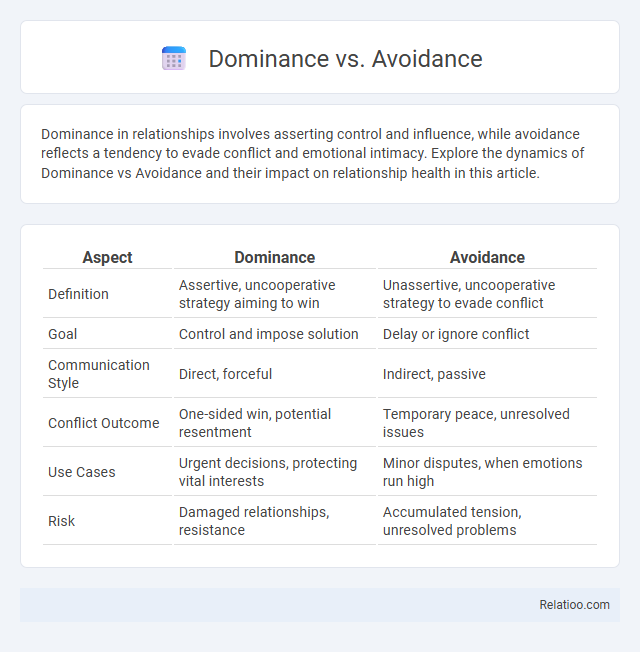Dominance in relationships involves asserting control and influence, while avoidance reflects a tendency to evade conflict and emotional intimacy. Explore the dynamics of Dominance vs Avoidance and their impact on relationship health in this article.
Table of Comparison
| Aspect | Dominance | Avoidance |
|---|---|---|
| Definition | Assertive, uncooperative strategy aiming to win | Unassertive, uncooperative strategy to evade conflict |
| Goal | Control and impose solution | Delay or ignore conflict |
| Communication Style | Direct, forceful | Indirect, passive |
| Conflict Outcome | One-sided win, potential resentment | Temporary peace, unresolved issues |
| Use Cases | Urgent decisions, protecting vital interests | Minor disputes, when emotions run high |
| Risk | Damaged relationships, resistance | Accumulated tension, unresolved problems |
Understanding Dominance and Avoidance
Understanding dominance involves recognizing assertive behaviors where individuals seek control and influence in social or professional settings, often driving decision-making and leadership. Avoidance reflects a tendency to evade confrontation or challenging situations, prioritizing conflict reduction and emotional safety over direct engagement. Analyzing dominance and avoidance patterns reveals how interpersonal dynamics shape communication styles and power distribution within groups.
Key Differences Between Dominance and Avoidance
Dominance involves asserting control and influence over situations or people, while avoidance refers to evading conflict or difficult decisions to prevent discomfort. Your leadership style may reflect dominance through proactive decision-making and confrontation, whereas avoidance manifests in reluctance to address challenges directly. Key differences lie in dominance's emphasis on control and engagement versus avoidance's focus on withdrawal and postponement.
Psychological Foundations of Dominance
Dominance in psychological foundations is primarily rooted in social hierarchies and evolutionary survival mechanisms, driving individuals to assert control and influence within a group. Avoidance, by contrast, reflects a behavioral strategy aimed at minimizing conflict and threat exposure, often linked to anxiety and stress responses in the brain's amygdala. Understanding these contrasting mechanisms is crucial for analyzing interpersonal dynamics and leadership styles in social and organizational psychology.
The Roots of Avoidance Behavior
Avoidance behavior often stems from deep-rooted psychological mechanisms such as fear of failure, rejection, or negative consequences, which drive individuals to evade challenging situations. Your brain's amygdala plays a critical role in signaling threats, prompting avoidance as a survival strategy. Understanding these roots can help you develop healthier coping strategies to confront rather than escape difficulties.
Impact of Dominance in Relationships
Dominance in relationships often shapes power dynamics, influencing decision-making and communication patterns that can either strengthen or strain your connection. High dominance may lead to control issues, reducing mutual respect and emotional intimacy, while balanced dominance encourages assertiveness without aggression. Understanding how dominance affects trust and cooperation is crucial for fostering healthy, equitable partnerships.
How Avoidance Shapes Decision-Making
Avoidance influences decision-making by steering individuals away from potential losses or negative outcomes, often leading to risk-averse behaviors and delayed choices. This psychological pattern contrasts with dominance-driven decisions, where individuals seek control and assertiveness, and dominance in group dynamics, where power hierarchies affect outcomes. Understanding avoidance's role helps predict behaviors in high-stakes environments such as finance, healthcare, and conflict resolution.
Dominance vs Avoidance in the Workplace
Dominance vs Avoidance in the workplace highlights contrasting conflict management styles where dominance involves assertively pursuing one's goals, while avoidance entails sidestepping confrontation. Your ability to recognize when to adopt a dominant approach or when avoidance might preserve team harmony is crucial for effective leadership and conflict resolution. Understanding these dynamics supports improved communication, productivity, and workplace relationships.
Behavioral Signs to Identify Dominance and Avoidance
Behavioral signs of dominance include assertive body language, direct eye contact, and confident speech patterns that signal control and authority in interactions. Avoidance behavior is characterized by withdrawn posture, minimal eye contact, and evasive responses, indicating discomfort or unwillingness to engage. Recognizing these distinct behaviors helps you navigate social dynamics and respond effectively to dominance or avoidance cues.
Strategies for Balancing Dominance and Avoidance
Balancing dominance and avoidance requires strategic self-awareness and adaptive communication to maintain control without alienating others. You can employ assertive yet empathetic dialogue techniques to address conflicts while recognizing when to step back for better outcomes. Effective strategies include setting clear boundaries, practicing active listening, and selectively engaging in confrontations to optimize influence and cooperation.
Overcoming the Challenges of Dominance and Avoidance
Overcoming the challenges of dominance and avoidance requires recognizing the underlying motivations driving these behaviors and fostering open communication among individuals. Strategies such as active listening, empathy-building exercises, and establishing clear boundaries can help balance power dynamics and reduce conflict. Empowering all parties to express their needs respectfully encourages collaboration and long-term resolution.

Infographic: Dominance vs Avoidance
 relatioo.com
relatioo.com